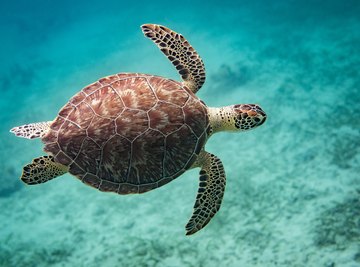
Turtles are recognizable animals which have a shell, four well-developed limbs and no teeth. A turtle’s top shell is called a carapace, while the bottom one is a plastron. Turtles are adapted in a number of specialized ways because of their habitats in oceans, seas, brackish water or in estuaries of large rivers.
Movement
Turtles have sleek and paddlelike forelimbs to propel them swiftly in water and claws for crawling on land. Their forelimbs have webbed feet for swimming. It is postulated that due to evolution, turtles have an increased number of vertebrae for speed or motion. They have eight neck vertebrae with highly mobile or flexible joints.
Breathing
Turtles have more than one lung located on the top of their shells for breathing. They also have two sets of muscles used in breathing. One set of muscles is responsible for stretching the body outward from the shell, which expands the body cavity of the turtle, thus allowing it to inhale, while the other set draws the body inward to exhale. Turtles have tissues in the back of their mouth that allow them to extract oxygen directly from water; this enables them to remain submerged in the water for 40 minutes. Leatherback sea turtles and soft-shelled turtles absorb oxygen from water via their shells. This is because their ribs are attached to the upper shell and are not used for breathing.
Eyesight
Turtles like the Galapagos, which stay on the land, have eyes facing downward, while those that spend most of their time in the water, like soft-shelled and snapping turtles, have eyes at the top of their head. They have good night vision because their eyes have many rods in the retina and cone cells for discerning color. This enables them to see a light spectrum that is invisible to human beings.
Feeding
Turtle hatchlings are carnivorous while adults are omnivores. Turtles do not have teeth, but their birdlike beaks and jaws are powerful, enabling them to crush, chew or tear food with ease. Black and green sea turtles have finely serrated jaws adapted for a vegetarian diet of algae and sea grasses. Hawksbill turtles have a narrow head with jaws meeting at an acute angle adapted for getting food from crevices in coral reefs. They feed on tunicates, squids, shrimps and sponges.
Defense
Hard and rough shells provide turtles with protection. Their shells have quick reflexes that allow them to bundle up inside when they come under threat from other animals. These shells have two hinges that draw upward and cover the soft parts of the turtle. Some species of turtles also have strong jaws and claws for defense. Chelonian turtles have developed other defense ploys like camouflage and biting as additional safeguards.
References
About the Author
Harold Debbi has been writing professionally since 2001. His articles have featured in the "Daily Express," "Good Housekeeping," "The Mirror" and "The People." Debbi holds a Masters of Arts in journalism from the University of Cambridge.
